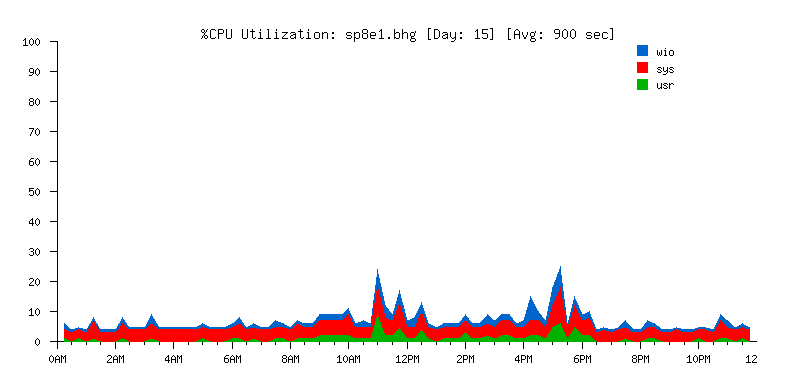#!/bin/sh
# This script prints tables out of AIX System Activity Reporting (sar).
# As option, the /var/adm/sa/xxstat files can be printed additionally.
# version 0.1 by Andreas Schmidt, 29MAY1998
echo "Content-type: text/html\n"
#Directory for Ploticus files
PLOT=/usr/local/httpd/ploticus must be adopted for your needs
OUT=/usr/local/httpd/htdocs/plots should be accessible by the web daemon
#QUERY_STRING contains:system=x&special=rep&start=#&end=#&day=#&i=#&opt=n
SYSTEM_special=`echo $QUERY_STRING|awk '{split($1,arr,"=");print arr[2]}'`
SYSTEM=`echo $SYSTEM_special|awk '{split($1,arr,"&");print arr[1]}'`
SPECIAL_start=`echo $QUERY_STRING|awk '{split($1,arr,"=");print arr[3]}'`
SPECIAL=`echo $SPECIAL_start|awk '{split($1,arr,"&");print arr[1]}'`
START_end=`echo $QUERY_STRING|awk '{split($1,arr,"=");print arr[4]}'`
START=`echo $START_end|awk '{split($1,arr,"&");print arr[1]}'`
END_day=`echo $QUERY_STRING|awk '{split($1,arr,"=");print arr[5]}'`
END=`echo $END_day|awk '{split($1,arr,"&");print arr[1]}'`
DAY_i=`echo $QUERY_STRING|awk '{split($1,arr,"=");print arr[6]}'`
DAY=`echo $DAY_i|awk '{split($1,arr,"&");print arr[1]}'`
I_opt=`echo $QUERY_STRING|awk '{split($1,arr,"=");print arr[7]}'`
I=`echo $I_opt|awk '{split($1,arr,"&");print arr[1]}'`
OPT=`echo $QUERY_STRING|awk '{split($1,arr,"=");print arr[8]}'|cut -c1`
# echo "$SYSTEM $SPECIAL $START $END $DAY $I $OPT"
if [ $SYSTEM = "all" ]
then
SYSTEM_QUERY="a list of your servers, e.g. alpha.dot.com beta.dot.com gamma.dot.com"
else
SYSTEM_QUERY="$SYSTEM"
fi
echo "<html><head><meta http-equiv=expires content=0></head>"
for SYS in $SYSTEM_QUERY
do
if [ $SPECIAL != "none" ]
then
echo "<CENTER><H2>Latest <I>/var/adm/sa/$SPECIAL</I> file content on <I>$SYS</I></H2></CENTER><PRE>"
remsh $SYS -l root cat /var/adm/sa/$SPECIAL
else
case $OPT in only the system wide statistics produces graphs!
u) sed s/%SYSTEM/$SYS/g $PLOT/sar.ptpl|\ follow the link to see the template
sed s/%START/$START/g|sed s/%END/$END/g|sed s/%DAY/$DAY/g|\
sed s/%I/$I/g > $PLOT/sar.p; the final inputfile for ploticus
$PLOT/pl $PLOT/sar.p -gif ;
STAMP=`date "+%y%m%d%H%M%S"`;
mv $PLOT/sar.gif $OUT/sar_$SYS$STAMP.gif;
echo "<p><a href=/plots/sar_$SYS$STAMP.gif target=_blank>\
<img src=/plots/sar_$SYS$STAMP.gif align=right width=380 height=200></a>";;
a small picture is displayed, with a link to the great picture in a new window
esac
case $OPT in
a) OPT_TEXT="file access system routines";;
b) OPT_TEXT="buffer activity for transfers, accesses, cache hit";;
c) OPT_TEXT="system calls";;
k) OPT_TEXT="kernel process activity";;
m) OPT_TEXT="message (send/receive) and semaphore (create, use, destroy) activities";;
q) OPT_TEXT="average number of kernel threads in run queue";;
r) OPT_TEXT="paging statistics";;
u) OPT_TEXT="system-wide statistics (default)";;
v) OPT_TEXT="status of process, kernel-thread, i-node, file tables";;
w) OPT_TEXT="system switching activity";;
y) OPT_TEXT="tty device activity per second";;
esac
echo "<H2>SAR Report on <I>$SYS</I>:<BR>$OPT_TEXT</H2><PRE>" the raw sar numbers will be displayed
remsh $SYS -l root /usr/sbin/sar -s $START:00 -e $END:01 -f /var/adm/sa/sa$DAY -i $I -$OPT
fi
echo "</pre><br clear=all><HR></P><p>"
done
|
 The following describes my approach to get actual pictures
like this out of sar data.
The following describes my approach to get actual pictures
like this out of sar data.![[link]](../gif/link.gif) this
example.
this
example.![[link]](../gif/link.gif) html form, inoked out of a web browser connected
to our Intranet. Our Webserver runs on one central server in our N/W. This server
has the authorisation via .rhosts to execute remote commands as root and as web
admin on all other servers. All graphs are produced on this central server so we
have only one ploticus installed.
html form, inoked out of a web browser connected
to our Intranet. Our Webserver runs on one central server in our N/W. This server
has the authorisation via .rhosts to execute remote commands as root and as web
admin on all other servers. All graphs are produced on this central server so we
have only one ploticus installed.![[link]](../gif/link.gif) sarform.htm
looks alike (comments are in red):
sarform.htm
looks alike (comments are in red):![[link]](../gif/link.gif) this original page produced with this form and script.
this original page produced with this form and script.